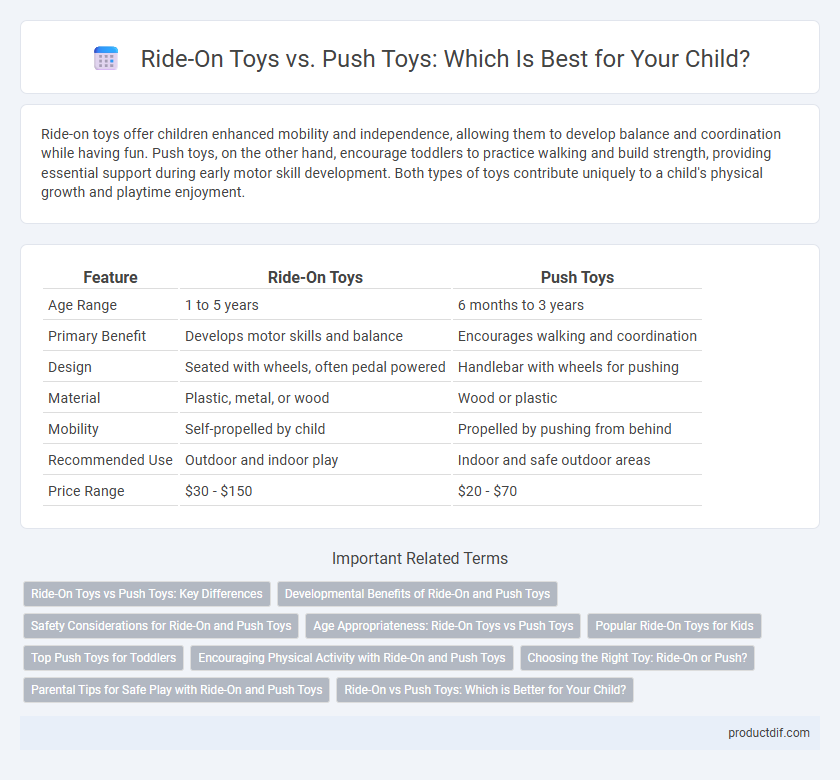Ride-on toys offer children enhanced mobility and independence, allowing them to develop balance and coordination while having fun. Push toys, on the other hand, encourage toddlers to practice walking and build strength, providing essential support during early motor skill development. Both types of toys contribute uniquely to a child's physical growth and playtime enjoyment.
Table of Comparison
| Feature | Ride-On Toys | Push Toys |
|---|---|---|
| Age Range | 1 to 5 years | 6 months to 3 years |
| Primary Benefit | Develops motor skills and balance | Encourages walking and coordination |
| Design | Seated with wheels, often pedal powered | Handlebar with wheels for pushing |
| Material | Plastic, metal, or wood | Wood or plastic |
| Mobility | Self-propelled by child | Propelled by pushing from behind |
| Recommended Use | Outdoor and indoor play | Indoor and safe outdoor areas |
| Price Range | $30 - $150 | $20 - $70 |
Ride-On Toys vs Push Toys: Key Differences
Ride-on toys offer more advanced motor skill development by enabling children to sit and propel themselves using feet, enhancing balance and coordination, whereas push toys primarily encourage walking and stability through forward movement support. Ride-on toys often feature interactive elements like steering wheels and sound effects, providing a multifaceted sensory experience compared to the simpler design of push toys. The choice between ride-on and push toys depends on the child's developmental stage and preferences, with ride-on toys suited for older toddlers seeking independence and push toys benefiting beginners learning to walk.
Developmental Benefits of Ride-On and Push Toys
Ride-on toys enhance gross motor skills by encouraging children to use leg muscles for propulsion, improving balance and coordination. Push toys support early walking by providing stability and promoting muscle strength in toddlers learning to walk. Both types of toys foster spatial awareness and motor planning, crucial for overall physical development in early childhood.
Safety Considerations for Ride-On and Push Toys
Ride-on toys and push toys differ significantly in safety considerations, with ride-ons requiring robust stability features and speed controls to prevent tipping accidents. Push toys demand careful design around handle height and wheel locking mechanisms to support proper posture and prevent falls in toddlers. Both toy types should adhere to ASTM F963 safety standards, including non-toxic materials and smooth edges, minimizing choking hazards and injuries.
Age Appropriateness: Ride-On Toys vs Push Toys
Ride-on toys are typically designed for children aged 18 months and older, promoting motor skills and balance as they scoot independently. Push toys suit younger toddlers, around 9 to 18 months, who are developing walking ability and need support for stability. Selecting age-appropriate toys ensures safety and enhances developmental benefits aligned with each stage of early childhood growth.
Popular Ride-On Toys for Kids
Popular ride-on toys for kids, such as electric cars, balance bikes, and pedal tricycles, offer enhanced motor skill development and long-lasting enjoyment compared to push toys. Ride-on toys promote physical activity by encouraging children to steer, pedal, or accelerate, which helps improve coordination and strength. Brands like Radio Flyer, Little Tikes, and Razor dominate the market with durable, age-appropriate models designed to engage toddlers and young children.
Top Push Toys for Toddlers
Top push toys for toddlers promote motor skill development and balance through interactive features such as buttons, sounds, and steering capabilities. Unlike ride-on toys, push toys encourage walking and coordination by requiring the child to propel the toy forward using their own strength. Popular models like the VTech Sit-to-Stand Learning Walker and Fisher-Price Brilliant Basics Push Along Walker combine educational elements with physical activity to support early childhood growth.
Encouraging Physical Activity with Ride-On and Push Toys
Ride-on toys and push toys are instrumental in promoting physical activity among young children by enhancing gross motor skills, balance, and coordination. Ride-on toys provide an engaging way for kids to develop muscle strength and spatial awareness through active steering and propulsion. Push toys encourage walking and balance, fostering early mobility and confidence essential for physical development.
Choosing the Right Toy: Ride-On or Push?
Ride-on toys enhance motor skills by encouraging toddlers to balance and steer, ideal for ages 18 months and up, while push toys support early walking stages by providing stability and coordination for infants 9 months and older. Consider the child's developmental stage and safety features such as non-slip wheels and sturdy frames when selecting between ride-on or push toys. Prioritize age-appropriate designs to promote physical activity and cognitive growth effectively.
Parental Tips for Safe Play with Ride-On and Push Toys
Parents should ensure ride-on and push toys meet safety standards by checking for sturdy construction, smooth edges, and non-toxic materials. Supervision is crucial during playtime to prevent falls and collisions, and children should use age-appropriate helmets or protective gear when riding. Regularly inspecting toys for wear and tear helps maintain safety and prolongs the toy's usability.
Ride-On vs Push Toys: Which is Better for Your Child?
Ride-on toys promote motor skill development and balance by encouraging children to sit and steer, enhancing coordination and independence. Push toys support toddlers learning to walk by providing stability and confidence during early mobility stages. Selecting between ride-on and push toys depends on your child's developmental milestones and physical abilities to maximize growth benefits.
Ride-on toys vs push toys Infographic

 productdif.com
productdif.com